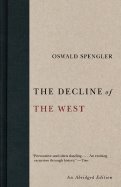![]()
史賓格勒(Oswald Spengler)著《西方的沒落》(The Decline of the West),以下是當初我在看的時候,留下的非常簡單的筆記。
 西方的沒落
西方的沒落
The Decline of the West
ISBN: 9573206641
作者:Oswald Spengler
譯者:陳曉林
精平裝/頁數:精裝本 / 752頁
出版社:遠流出版社
出版日: 93/10/01
圖書分類:歷史學
定 價: 400元
古典文化的靈魂:阿波羅式——有形的個體
西方文化的靈魂:浮士德式——無盡的空間
史賓格勒認為文化是有機體,有著生命的模式,可用季節來類比。文化之春是其最原始的基本原則,也就是其宗教誕生之時。他相信所有偉大文化的背後必有一偉大的宗教。
文化是有機體
一個文化開始成形(與運動員處於顛峰期相較),即是其夏日,當所有外觀都在其文化的基本原則下運作,是其偉大成就——永恆價值——的完成期。
我們的文化和其他文化相比,是一種導向和意志的產物(directedness and will),史氏比之為浮士德。我們的宗教要求我們去改變他人;我們的藝術有透視法,這是一種觀點和方向;我們的音樂導向音調中心;我們的科學是關於力和 變化,而我們用來改變世界;我們的數學從古典的靜態幾何走出,處理的是微積分,傾向和平均數(calculus, tendencies, averages)。
所有文化進入文明階段,是開始走下坡的秋。多城市是這個時期的典型,政策受到金錢的趨策,從帝國主義走向國家競爭階段,再到獨裁(凱撒主義Caesarism),再到君主專制時代。
科學不再達到必然,人民不再接受共同原則和目標,他們抗拒過去的一切教條,藝術,不再找尋對藝術家和民眾而言的明確道路,而去追隨多變的時尚模式。這個文化經過無神論階段後,人們轉向以這文化孕育初期(春天期)的宗教為基礎的宗教更新。
史氏認為我們的文化約在十八世紀就結束了夏天——1770年文學,和華格納的音樂。他將藝術的發展視為衰退的跡象,他對這些處於文明階段的人的建議是,去找尋運動的方向並做出正面的貢獻——文明將走向其最終命運,不論我們的選擇為何,但我們可選擇做出努力或束手不管。
「如果相同的事物,在無限的時空中,周而復始的川流不息,
像成千上萬的拱柱,彼此緊密交錯,生生不息。
則不論大小星辰,萬事萬物,皆能充滿生機,妙含逸趣,
洋溢出生命的歡欣。
而一切掙扎,一切奮鬥,一切吶喊,在上帝眼中,
卻是永恆的安寧而已。
——哥德」
基本象徵
「所 謂『基本象徵』,也就是每一文化的『有力主題』,一個文化的生命歷程,也就是它開展和實現它自己的主題的全部過程,因此基本象徵與文化生命,彼此密不可 分。史氏認為:古典文化的『基本象徵』是『有限的實體』、西方文化的『基本象徵』是『無窮的空間』、阿拉伯文化的『基本象徵』是『洞穴』、中國文化的『基本象徵』是『道』,此外,如俄羅斯的則是『無垠的平板』、埃及的則是一種『路途』……待一個文化的主題,其全部的形式內涵均已發揮殆盡、完滿實現之後,這 個文化也就完成了自己的使命,也走完了生命的歷程。」(譯者前言)
「……我在此處,把帝國主義當作文化終結的典型象徵。它是僵化了的死物體,一些殘渣剩滓而已,有如埃及帝國、有如羅馬、中國、印度帝國那般。帝國主義正是不折不扣的文明。……文化人的能力,指向於內在,而文明人的能力,則發揮於外在……」(第一章 )
「靈魂即是廣延的補足物(Soul is the Complement of Extension),故而最終必趨向於擴張。」(第一章)
「…… 『上帝是在生命之中,而非死亡之中;是在生成與變化之中,而非完成與固定之內,發揮作用。故而,同樣地,理性(Vernunft)是專心致力於透過 生長變化與生命流行,而追求神性;而理解(Verstand)卻只利用到已經完成與固定的事物。』這句話正包攝了我整個的哲學。」(第一章附註)
The Godhead is effective in the living and not in the dead, in the becoming and the changing, not in the become and the set-fast; and therefore, the reason is concerned only to strive towards the divine through the becoming and the living, and the understanding only to make use of the become and the set-fast.
偶然的概念
「每一個活生生的文化,最後都會達到其內在與外在的完成狀態,達到其終結——這便是所有的所謂歷史的「沒落」(decline)的意義。古典文化的沒落,是我們知道得非常清楚而完整的。」(第三章)
「莎士比亞作品的特獨與氣勢,乃是由他的洞察力來的。……他是一位注重「偶然」(the Incidental)的劇作家。而此一「偶然」的概念,正是西方悲劇的核心,而西方的悲劇,則又正是西方歷史觀的一個真實投影。……在哈姆雷特中,王子 的政治地位、國王的被謀殺、加上繼承問題,一起撞擊著哈姆雷特那憂鬱的性格,故而,這是一種偶然的悲劇。或以奧賽羅為例,依阿高(Iago)這個可以在任 何街上找到的、庸凡的無賴惡漢,恰好以具有特殊性向的奧賽羅,為攻訐的目標,這也是一種偶然。再看李爾王!還有什麼事比這更偶然(所以也更「自然」)的 呢?國王那號令天下的威嚴,卻與那些要命的熱情,同存在一個人身上,而他的女兒們,卻又一心垂涎於他的王位,這不是偶然的悲劇嗎?……莎士比亞一發現了他 所要寫的故事,便把那些故事,充滿了內在必然的力量,而羅馬的戲劇中,便從沒有如此雄偉的氣勢。」(第三章)
培嘉門與貝魯特:藝術之終結(第七章末)
PERGAMUM AND BAYREUTH: THE END OF ART [155-6]
The last of the Faustian arts died in Tristan. This work is the giant keystone of Western music. Painting achieved nothing like this as a finale. ...
The symptom of decline in creative power is the fact that to produce something round and complete the artist now requires to be emancipated from form and proportion. Its most obvious though not its most significant, manifestation is the taste for the gigantic. Here size is not, as in the Gothic and the Pyramid styles, the expression of inward greatness, but the dissimulation of its absence. This swaggering in specious dimensions is common to all nascent Civilizations--we find it in the Zeus altar of Pergamum, the Helios of Chares called the "Colossus of Rhodes," the architecture of the Roman Imperial Age, the New Empire work in Egypt, and American skyscraper of today. ....
Between Wagner and Manet there is a deep relationship, which is not, indeed obvious to everyone but which Baudelaire with his unerring flair for the decadent detected at once. For the Impressionists, the end and the culmination of art was the conjuring up of a world in space out of strokes and patches of colour, and this was just what Wagner achieved in three bars. A whole world of soul could crowd into these three bars. ... Here the contrast of Western music with greek plastic has reached its maximum. Everything merges in bodiless infinity, o longer even does a linear melody wrestle itself clear of the vague tone-masses that in strange surgings challenge an imaginary space. The motive comes up out of dark terrible deeps. It is flooded for an instant by a flash of hard bright sun. then, suddenly, it is so close upon us that we shrink...
All that Nietzsche says of Wagner is applicable, also, to Manet. Ostensibly a return to the elemental, to Nature, as against contemplation-painting and abstract music, their art really signifies a concession to the barbarism of the Megalopolis, the beginning of dissolution sensibly manifested in a mixture of brutality and refinement. As a step, it is necessarily the last step. An artificial art has no further organic future, it is the mark of the end.
And the bitter conclusion is that it is all irretrievably over with the arts of form of the West. The crisis of the nineteenth century was the death-struggle. Like the Apollinian, the Egyptian and every other, the Faustian art dies of senility, having actualized its inward possibilities and fulfilled its mission within the course of its Culture
What is practiced as art today--be it music after Wagner or painting after Manet, Cezanne, Leible and Menzel-- is impotence and falsehood. One thing is quite certain, that today every single art-school could be shut down without art being affected in the slightest. We can learn all we wish to know about the art-clamour which a megalopolis sets up in order to forget that its art is dead form the Alexandria of the year 200. There, as here in our world-cities, we find a pursuit of illusions of artistic progress, of personal peculiarity, of "the new style," of "unsuspected possibilities," theoretical babble, pretentious fashionable artists, weight-lifters with cardboard dumb-bells--the "Literary Man" in the Poet's place, the unabashed farce of Expressionism, which the art-trade has organized as a "phase of art-history," thinking and felling and forming as industrial art. Alexandria, too, had problem-dramatists and box-office artists whom it preferred to Sophocles and painters who invented new tendencies and successfully bluffed their public. The final result is that endless industrious repetition of a stock of fixed forms which we see today in Indian Chinese and Arabian-persian art. Pictures and fabrics, verses and vessels, furniture, dramas and musical compositions--all is pattern-work. We cease to be able to date anything within centuries, let alone decades, by the language of its ornamentation. So it has been in the Last Act of all Cultures.




0 意見:
張貼留言